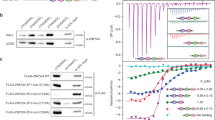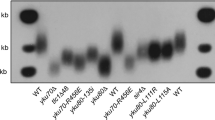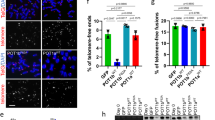Abstract
Human telomeres are associated with ATM and the protein complex consisting of MRE11, RAD50 and NBS1 (MRN), which are central to maintaining genomic stability. Here we show that when targeted to telomeres, wild-type RAD50 downregulates telomeric association of TRF1, a negative regulator of telomere maintenance. TRF1 binding to telomeres is upregulated in cells deficient in NBS1 or under ATM inhibition. The TRF1 association with telomeres induced by ATM inhibition is abrogated in cells lacking MRE11 or NBS1, suggesting that MRN and ATM function in the same pathway controlling TRF1 binding to telomeres. The ability of TRF1 to interact with telomeric DNA in vitro is impaired by ATM-mediated phosphorylation. We propose that MRN is required for TRF1 phosphorylation by ATM and that such phosphorylation results in the release of TRF1 from telomeres, promoting telomerase access to the ends of telomeres.
This is a preview of subscription content, access via your institution
Access options
Subscribe to this journal
Receive 12 print issues and online access
$189.00 per year
only $15.75 per issue
Buy this article
- Purchase on Springer Link
- Instant access to full article PDF
Prices may be subject to local taxes which are calculated during checkout








Similar content being viewed by others
References
de Lange, T. Shelterin: the protein complex that shapes and safeguards human telomeres. Genes Dev. 19, 2100–2110 (2005).
van Steensel, B., Smogorzewska, A. & de Lange, T. TRF2 protects human telomeres from end-to-end fusions. Cell 92, 401–413 (1998).
van Steensel, B. & de Lange, T. Control of telomere length by the human telomeric protein TRF1. Nature 385, 740–743 (1997).
Ancelin, K. et al. Targeting assay to study the cis functions of human telomeric proteins: evidence for inhibition of telomerase by TRF1 and for activation of telomere degradation by TRF2. Mol. Cell. Biol. 22, 3474–3487 (2002).
Chong, L. et al. A human telomeric protein. Science 270, 1663–1667 (1995).
Cooper, J.P., Nimmo, E.R., Allshire, R.C. & Cech, T.R. Regulation of telomere length and function by a Myb-domain protein in fission yeast. Nature 385, 744–747 (1997).
Marcand, S., Gilson, E. & Shore, D. A protein-counting mechanism for telomere length regulation in yeast. Science 275, 986–990 (1997).
Verdun, R.E., Crabbe, L., Haggblom, C. & Karlseder, J. Functional human telomeres are recognized as DNA damage in G2 of the cell cycle. Mol. Cell 20, 551–561 (2005).
Verdun, R.E. & Karlseder, J. The DNA damage machinery and homologous recombination pathway act consecutively to protect human telomeres. Cell 127, 709–720 (2006).
Zhu, X.D., Kuster, B., Mann, M., Petrini, J.H. & Lange, T. Cell-cycle-regulated association of RAD50/MRE11/NBS1 with TRF2 and human telomeres. Nat. Genet. 25, 347–352 (2000).
Xiao, Y. & Weaver, D.T. Conditional gene targeted deletion by Cre recombinase demonstrates the requirement for the double-strand break repair Mre11 protein in murine embryonic stem cells. Nucleic Acids Res. 25, 2985–2991 (1997).
Luo, G. et al. Disruption of mRad50 causes embryonic stem cell lethality, abnormal embryonic development, and sensitivity to ionizing radiation. Proc. Natl. Acad. Sci. USA 96, 7376–7381 (1999).
Zhu, J., Petersen, S., Tessarollo, L. & Nussenzweig, A. Targeted disruption of the Nijmegen breakage syndrome gene NBS1 leads to early embryonic lethality in mice. Curr. Biol. 11, 105–109 (2001).
Stewart, G.S. et al. The DNA double-strand break repair gene hMRE11 is mutated in individuals with an ataxia-telangiectasia-like disorder. Cell 99, 577–587 (1999).
Varon, R. et al. Nibrin, a novel DNA double-strand break repair protein, is mutated in Nijmegen breakage syndrome. Cell 93, 467–476 (1998).
Carney, J.P. et al. The hMre11/hRad50 protein complex and Nijmegen breakage syndrome: linkage of double-strand break repair to the cellular DNA damage response. Cell 93, 477–486 (1998).
Savitsky, K. et al. A single ataxia telangiectasia gene with a product similar to PI-3 kinase. Science 268, 1749–1753 (1995).
D'Amours, D. & Jackson, S.P. The Mre11 complex: at the crossroads of DNA repair and checkpoint signalling. Nat. Rev. Mol. Cell Biol. 3, 317–327 (2002).
Haber, J.E. The many interfaces of Mre11. Cell 95, 583–586 (1998).
de Lange, T. & Petrini, J. A new connection at human telomeres: association of the Mre11 complex with TRF2. Cold Spring Harb. Symp. Quant. Biol. 65, 265–273 (2000).
Nugent, C.I. et al. Telomere maintenance is dependent on activities required for end repair of double-strand breaks. Curr. Biol. 8, 657–660 (1998).
Tsukamoto, Y., Taggart, A.K. & Zakian, V.A. The role of the Mre11-Rad50-Xrs2 complex in telomerase- mediated lengthening of Saccharomyces cerevisiae telomeres. Curr. Biol. 11, 1328–1335 (2001).
Ritchie, K.B. & Petes, T.D. The Mre11p/Rad50p/Xrs2p complex and the Tel1p function in a single pathway for telomere maintenance in yeast. Genetics 155, 475–479 (2000).
Metcalfe, J.A. et al. Accelerated telomere shortening in ataxia telangiectasia. Nat. Genet. 13, 350–353 (1996).
Ranganathan, V. et al. Rescue of a telomere length defect of Nijmegen breakage syndrome cells requires NBS and telomerase catalytic subunit. Curr. Biol. 11, 962–966 (2001).
Kishi, S. et al. Telomeric protein Pin2/TRF1 as an important ATM target in response to double strand DNA breaks. J. Biol. Chem. 276, 29282–29291 (2001).
Wu, G., Lee, W.H. & Chen, P.L. NBS1 and TRF1 colocalize at PML bodies during late S/G2 phases in immortalized telomerase-negative cells: implication of NBS1 in alternative lengthening of telomeres. J. Biol. Chem. 275, 30618–30622 (2000).
Kishi, S. & Lu, K.P. A critical role for Pin2/TRF1 in ATM-dependent regulation. Inhibition of Pin2/TRF1 function complements telomere shortening, radiosensitivity, and the G2/M checkpoint defect of ataxia-telangiectasia cells. J. Biol. Chem. 277, 7420–7429 (2002).
Li, B., Oestreich, S. & de Lange, T. Identification of human Rap1: implications for telomere evolution. Cell 101, 471–483 (2000).
Evans, S.K. & Lundblad, V. Est1 and Cdc13 as comediators of telomerase access. Science 286, 117–120 (1999).
Hopfner, K.P. et al. Structural biology of Rad50 ATPase: ATP-driven conformational control in DNA double-strand break repair and the ABC-ATPase superfamily. Cell 101, 789–800 (2000).
Paull, T.T. & Gellert, M. Nbs1 potentiates ATP-driven DNA unwinding and endonuclease cleavage by the Mre11/Rad50 complex. Genes Dev. 13, 1276–1288 (1999).
Moncalian, G. et al. The rad50 signature motif: essential to ATP binding and biological function. J. Mol. Biol. 335, 937–951 (2004).
Alani, E., Padmore, R. & Kleckner, N. Analysis of wild-type and rad50 mutants of yeast suggests an intimate relationship between meiotic chromosome synapsis and recombination. Cell 61, 419–436 (1990).
Lee, J.H. & Paull, T.T. ATM activation by DNA double-strand breaks through the Mre11-Rad50-Nbs1 complex. Science 308, 551–554 (2005).
Smogorzewska, A. et al. Control of human telomere length by TRF1 and TRF2. Mol. Cell. Biol. 20, 1659–1668 (2000).
Kraakman-van der Zwet, M. et al. Immortalization and characterization of Nijmegen Breakage syndrome fibroblasts. Mutat. Res. 434, 17–27 (1999).
Hickson, I. et al. Identification and characterization of a novel and specific inhibitor of the ataxia-telangiectasia mutated kinase ATM. Cancer Res. 64, 9152–9159 (2004).
Jazayeri, A. et al. ATM- and cell cycle-dependent regulation of ATR in response to DNA double-strand breaks. Nat. Cell Biol. 8, 37–45 (2006).
Bianchi, A., Smith, S., Chong, L., Elias, P. & de Lange, T. TRF1 is a dimer and bends telomeric DNA. EMBO J. 16, 1785–1794 (1997).
Ziv, Y. et al. Cellular and molecular characteristics of an immortalized ataxia-telangiectasia (group AB) cell line. Cancer Res. 49, 2495–2501 (1989).
Chai, W., Sfeir, A.J., Hoshiyama, H., Shay, J.W. & Wright, W.E. The involvement of the Mre11/Rad50/Nbs1 complex in the generation of G-overhangs at human telomeres. EMBO Rep. 7, 225–230 (2006).
Lee, J.H. & Paull, T.T. Direct activation of the ATM protein kinase by the Mre11/Rad50/Nbs1 complex. Science 304, 93–96 (2004).
Falck, J., Coates, J. & Jackson, S.P. Conserved modes of recruitment of ATM, ATR and DNA-PKcs to sites of DNA damage. Nature 434, 605–611 (2005).
You, Z., Chahwan, C., Bailis, J., Hunter, T. & Russell, P. ATM activation and its recruitment to damaged DNA require binding to the C terminus of Nbs1. Mol. Cell. Biol. 25, 5363–5379 (2005).
Robison, J.G., Elliott, J., Dixon, K. & Oakley, G.G. Replication protein A and the Mre11·Rad50·Nbs1 complex co-localize and interact at sites of stalled replication forks. J. Biol. Chem. 279, 34802–34810 (2004).
Trenz, K., Smith, E., Smith, S. & Costanzo, V. ATM and ATR promote Mre11 dependent restart of collapsed replication forks and prevent accumulation of DNA breaks. EMBO J. 25, 1764–1774 (2006).
Masutomi, K. et al. Telomerase maintains telomere structure in normal human cells. Cell 114, 241–253 (2003).
Chamankhah, M. & Xiao, W. Formation of the yeast Mre11-Rad50-Xrs2 complex is correlated with DNA repair and telomere maintenance. Nucleic Acids Res. 27, 2072–2079 (1999).
Kironmai, K.M. & Muniyappa, K. Alteration of telomeric sequences and senescence caused by mutations in RAD50 of Saccharomyces cerevisiae. Genes Cells 2, 443–455 (1997).
Ritchie, K.B., Mallory, J.C. & Petes, T.D. Interactions of TLC1 (which encodes the RNA subunit of telomerase), TEL1, and MEC1 in regulating telomere length in the yeast Saccharomyces cerevisiae. Mol. Cell. Biol. 19, 6065–6075 (1999).
Ray, A. & Runge, K.W. Varying the number of telomere-bound proteins does not alter telomere length in tel1Δ cells. Proc. Natl. Acad. Sci. USA 96, 15044–15049 (1999).
Craven, R.J. & Petes, T.D. Dependence of the regulation of telomere length on the type of subtelomeric repeat in the yeast Saccharomyces cerevisiae. Genetics 152, 1531–1541 (1999).
Wilson, S., Warr, N., Taylor, D.L. & Watts, F.Z. The role of Schizosaccharomyces pombe Rad32, the Mre11 homologue, and other DNA damage response proteins in non-homologous end joining and telomere length maintenance. Nucleic Acids Res. 27, 2655–2661 (1999).
Ueno, M. et al. Molecular characterization of the Schizosaccharomyces pombe nbs1+ gene involved in DNA repair and telomere maintenance. Mol. Cell. Biol. 23, 6553–6563 (2003).
Hartsuiker, E., Vaessen, E., Carr, A.M. & Kohli, J. Fission yeast Rad50 stimulates sister chromatid recombination and links cohesion with repair. EMBO J. 20, 6660–6671 (2001).
Manolis, K.G. et al. Novel functional requirements for non-homologous DNA end joining in Schizosaccharomyces pombe. EMBO J. 20, 210–221 (2001).
Nakamura, T.M., Moser, B.A. & Russell, P. Telomere binding of checkpoint sensor and DNA repair proteins contributes to maintenance of functional fission yeast telomeres. Genetics 161, 1437–1452 (2002).
Wang, R.C., Smogorzewska, A. & de Lange, T. Homologous recombination generates T-loop-sized deletions at human telomeres. Cell 119, 355–368 (2004).
Loayza, D. & De Lange, T. POT1 as a terminal transducer of TRF1 telomere length control. Nature 423, 1013–1018 (2003).
Acknowledgements
We thank T. de Lange (Rockefeller University) for providing crucial reagents, including wild-type RAP1, plasmids pLPC-Myc-RAD50, pcDNA3-Myc-TRF1 and pTH12, antibodies to RAD50, MRE11, NBS1, RAP1, TRF2 and TRF1, cell lines AT22IJE-T and NBS-ILB1 stably expressing pBabe-puro or pBabe-puro-NBS1, and baculovirus-derived recombinant TRF1. We also thank J. Petrini (Sloan-Kettering Institute) for wild-type RAD50 complementary DNA and the cell line ATLD2, and J.R. Walker and members of the Zhu laboratory for critical comments. X.-D.Z. is a Canadian Institutes of Health Research New Investigator, and this work was supported by grants from the Canadian Institutes of Health Research and the Natural Sciences and Engineering Research Council of Canada.
Author information
Authors and Affiliations
Contributions
Y.W. and S.X. performed the experiments. X.-D.Z. conceived and analyzed the experiments and wrote the paper.
Corresponding author
Ethics declarations
Competing interests
The authors declare no competing financial interests.
Supplementary information
Supplementary Text and Figures
Supplementary Figures 1–4 (PDF 2739 kb)
Rights and permissions
About this article
Cite this article
Wu, Y., Xiao, S. & Zhu, XD. MRE11–RAD50–NBS1 and ATM function as co-mediators of TRF1 in telomere length control. Nat Struct Mol Biol 14, 832–840 (2007). https://doi.org/10.1038/nsmb1286
Received:
Accepted:
Published:
Issue Date:
DOI: https://doi.org/10.1038/nsmb1286
This article is cited by
-
MicroRNA regulation of the MRN complex impacts DNA damage, cellular senescence, and angiogenic signaling
Cell Death & Disease (2018)
-
The role of telomere binding molecules for normal and abnormal hematopoiesis
International Journal of Hematology (2018)
-
ATM and CDK2 control chromatin remodeler CSB to inhibit RIF1 in DSB repair pathway choice
Nature Communications (2017)
-
Genomic Integrity Is Favourably Affected by High-Intensity Interval Training in an Animal Model of Early-Stage Chronic Kidney Disease
Sports Medicine - Open (2016)
-
Targeting Rad50 sensitizes human nasopharyngeal carcinoma cells to radiotherapy
BMC Cancer (2016)



